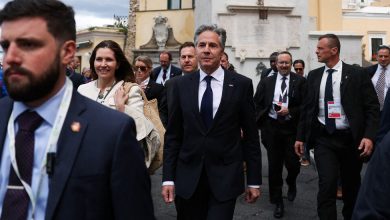Tough Questions for West as Ukraine Cities Teeter

LYSYCHANSK, Ukraine — With Russia about to encircle Sievierodonetsk, a city critical to its goal of seizing Ukraine’s east, and with a neighboring city squarely in Moscow’s sights, the question of how realities on the ground will shape the next phase of the war became still more pressing Sunday for Ukraine’s Western allies.
“The Russians are making every effort to cut off Sievierodonetsk,” the regional governor, Serhiy Haidai, said Sunday on Telegram, the messaging app. “The next two or three days will be significant.”
Across the river, Ukrainians trying to hold fast against the Russians in Lysychansk had the advantage of good terrain — but dwindling weaponry to defend it with.
“If there is no help with military equipment, of course they will drive us out,” said Oleksandr Voronenko, 46, a military police officer stationed in Lysychansk. “Because everyday the equipment is destroyed. You have to replace it with something new.”
Ukrainian officials have been imploring NATO allies for faster delivery of longer-range weapons, and the urgently needed replenishment of still more basic supplies, including ammunition.
But with the momentum of the war shifting more decisively in Russia’s favor, Ukraine’s allies, their economies threatened and their resolve tested, may soon find themselves forced to confront far more fundamental questions than what sort of weapons to provide, including whether to put pressure on Ukraine to reach a peace agreement with Russia or risk Russian escalation with more aggressive military support.
“There was always a sense that, when the center of gravity shifted to the south and east, there would be the potential for greater Russian gains based on greater mass and their existing territorial acquisitions,” said Ian Lesser, a former American official who heads the Brussels office of the German Marshall Fund.
“But it does raise more serious longer-term questions about the nature of the conflict, Ukraine’s aims and Western aims in relation to those,” he said.
As Ukrainians wait, they are suffering horrific losses in the Donbas region where the fight for Sievierodonetsk is playing out. By Ukraine’s own assessment, it is losing between 100 and 200 people a day as the bloodshed there worsens, in part because of Russian material superiority and in part because of Ukraine’s determination to fight on despite the increasingly bleak picture in the east.
Those Western supplies that have made it through to the front line are neither as plentiful or as sophisticated as Ukraine would like. And some never even make it into battle, hit by Russian strikes before they can even be deployed.
Late Saturday, Russian missiles hit a military warehouse in western Ukraine, wounding nearly two dozen people, and, according to Russia’s Defense Ministry, destroying antitank and antiaircraft missile systems supplied to Ukraine by the United States and the European Union.
The Ukrainian government has poured troops and resources into its effort to hold on to Sievierodonetsk, a strategically important industrial city and the last major urban center in the Donbas region of Luhansk that has not yet fallen. Russian forces have destroyed two bridges leading to the center of Sievierodonetsk and were shelling the remaining one, an important supply line for Ukrainian forces, the regional governor said.
Now, the battle may be about to shift to its sister city, Lysychansk.
On Sunday, from atop a hill in Lysychansk, it was evident why the soon to be focal point of the Russian offensive appears easier to defend than other parts of Donbas: It is on high ground. The sprawling plains of the region are rich in natural resources, but elevation is a rarity.
That leaves the city’s Ukrainian defenders in an advantageous position.
But it’s impossible to defend Lysychansk, a city with a prewar population of roughly 100,000, without the supplies needed to keep Ukrainian tanks and artillery stocked with shells and the thousands of troops garrisoned there fed and equipped.
This is the challenge the Ukrainian military is facing now as Russian forces near the end of their campaign to seize neighboring Sievierodonetsk. Even with Sievierodonetsk captured, Ukrainian troops could most likely defend Lysychansk, in part because the Seversky Donets River separates the two cities — unless Russian forces succeed in severing the city’s supply routes.
It was clear Sunday that the Russians were attempting to accomplish just that by steadily advancing from the southeast.
Plumes of smoke and burning fields where artillery strikes had lit the ground on fire enveloped Lysychansk in a semicircle on Sunday afternoon. The frequent thuds of incoming and outgoing fire echoed across the city as civilians dragged empty bottles to fill up from a fire department water tanker jury-rigged with clean-water filters.
Last week, Ukraine’s president, Volodymyr Zelensky, said that “in many ways, the fate of our Donbas is being decided” around Sievierodonetsk and Lysychansk. But the first city is now virtually encircled, and if Russian forces continue to advance toward the mix of asphalt and bumpy field roads that serve as the only logistics pipeline into the second, Ukrainian officials will have to make a strategic decision: withdraw or risk an encirclement of Lysychansk, too.
“We’re waiting for reinforcements,” said Mr. Voronenko, the military police officer, as a Group of 20 or so residents began moving toward evacuation vans. “It has partly arrived in the last several days in the form of artillery. And if we get more, then we can probably hold them off.”
But nearly four months after Russia invaded, the Ukrainian military is running low on ammunition for its Soviet-era artillery and is not receiving enough ammunition, fast enough, leaving the fate of Lysychansk even more uncertain.
For European countries, the question of how to defend Ukraine now is both tactical and political — and raises issues closer to home.
Russia-Ukraine War: Key Developments
On the ground. A Ukrainian official said that Russia could soon mount a push to completely encircle the city of Sievierodonetsk. Capturing the city would give the Kremlin a key victory in its bid to control all of the eastern Donbas region, where Moscow’s forces are pressing their advantage in numbers and longer-range weapons to wrest momentum in the grinding war.
In the south. The Kremlin is trying to deepen its hold on occupied territory in the south, restoring rail links and other key infrastructure. But there are some indications that Moscow is struggling to govern the southern areas, amid attacks by a nascent insurgency made up of Ukrainian civilians and former soldiers and a possible health crisis in Mariupol.
Short on weapons. Ukraine has been making desperate pleas for the West to speed up the delivery of heavy weapons, as its troops find themselves badly outgunned. The Russian forces, meanwhile, appear to be running low on precision missiles. This shortage has led the Russians to resort to inefficient weapons systems that are less precise but can still cause major damage, according to Britain’s Defense Ministry.
E.U. membership for Ukraine. The European Union is evaluating Ukraine’s application to become a candidate to join its 27-member bloc. The decision, which is expected in late June, will test the E.U. as it tries to figure out ways to bind vulnerable countries like Ukraine, Moldova and Georgia to Europe without creating security risks.
Prisoners of war. Russian investigators said they had opened more than 1,100 cases into “crimes against peace” committed by the Ukrainian government, paving the way for what could turn into a mass show trial of hundreds of Ukrainian service members. Two Britons and a Moroccan who had fought for the Ukrainian armed forces, meanwhile, were sentenced to death by a court in Russia-occupied eastern Ukraine after being accused of being mercenaries.
Several E.U. members are fretting that they have sent too much of their own ammunition to Ukraine and are lagging behind in restocking their arsenals. With the bloc’s foreign policy and defense not integrated, European leaders have been forced to try source their own military supplies.
European Union officials say they will try to tap a nine billion euro ($9.5 billion) funding pot to jointly procure military equipment, flexing a nascent muscle and trying to ease concerns that supporting Ukraine militarily has dangerously weakened defense capabilities elsewhere in Europe.
The bloc is also wrestling with the broader and politically fraught question of how to move forward with Ukraine’s bid to enter the European Union.
In a visit to Kyiv Saturday, president Ursula von der Leyen of the European Commission said her administration would provide an opinion on whether the bloc should grant candidate status to Ukraine by the end of the week. Ultimately, however, the decision is a deeply political one that E.U. leaders will be called to answer at a summit June 23 and 24 in Brussels.
For most countries granted candidate status, it takes more than a decade of reforms and negotiations to become a full E.U. member.
Should Ukraine be given a green light, its road forward will most likely be difficult, considering the nation’s dire situation since the onset of war and the poor governance and corruption that marked it even before the invasion.
“Whatever the territorial reality on the ground, having that deepening prospect of Euro-Atlantic integration for Ukraine is very meaningful,” said Mr. Lesser of the German Marshall Fund. “And to the extent that it fosters a growing prospect of an increasingly Westernized Ukraine versus a Russia that’s drifted out into an Asiatic imperial posture, the political contrast between these two actors will become more stark.”
Thomas Gibbons-Neff reported from Lysychansk, and Matina Stevis-Gridneff from Brussels. Natalia Yermak contributed reporting from Lysychansk.




